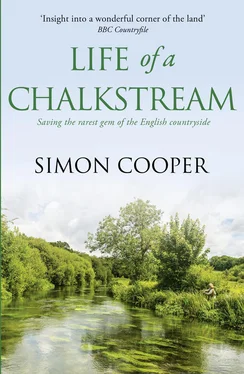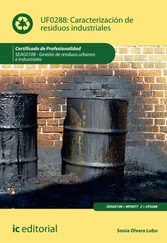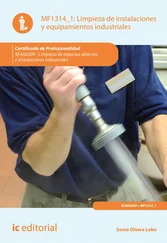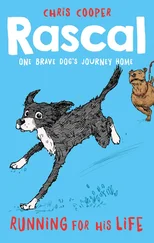COPYRIGHT CONTENTS Cover Title Page Copyright Dedication Epigraph 1 Discovery 2 Decline 3 Work begins 4 Spawning and the cycle of life 5 Scar Boy 6 March 7 How I held a trout for warmth 8 Mayday 9 The mayfly 10 Crayfish invasion 11 Midsummer’s Night 12 High summer 13 The English savanna 14 Cams Point Epilogue Bibliography Acknowledgements About the Publisher
William Collins
An imprint of HarperCollins Publishers 1, London Bridge Street, London SE1 9GF
WilliamCollinsBooks.com
This eBook first published in Great Britain by William Collins in 2014.
Text © Simon Cooper 2014
Illustrations © Chris Wormell 2014
Map © Liam Roberts 2014
The author asserts his moral right to be identified as the author of this work.
A catalogue record for this book is available from the British Library.
Cover photographs © Ken Takata. Designed by Kate Gaughran.
All rights reserved under International and Pan-American Copyright Conventions. By payment of the required fees, you have been granted the non-exclusive, non-transferable right to access and read the text of this e-book on-screen. No part of this text may be reproduced, transmitted, down-loaded, decompiled, reverse engineered, or stored in or introduced into any information storage and retrieval system, in any form or by any means, whether electronic or mechanical, now known or hereinafter invented, without the express written permission of HarperCollins.
Source ISBN: 9780007547869
eBook Edition © May 2014 ISBN: 9780007547876
Version: 2015-04-22
To Mary and Nigel. For endless encouragement and always being there.
For men may come and men may go,
But I go on for ever.
The Brook by Alfred Lord Tennyson
CONTENTS
Cover
Title Page
Copyright
Dedication To Mary and Nigel. For endless encouragement and always being there.
Epigraph For men may come and men may go, But I go on for ever. The Brook by Alfred Lord Tennyson
1 Discovery
2 Decline
3 Work begins
4 Spawning and the cycle of life
5 Scar Boy
6 March
7 How I held a trout for warmth
8 Mayday
9 The mayfly
10 Crayfish invasion
11 Midsummer’s Night
12 High summer
13 The English savanna
14 Cams Point
Epilogue
Bibliography
Acknowledgements
About the Publisher
1 CONTENTS Cover Title Page Copyright Dedication To Mary and Nigel. For endless encouragement and always being there. Epigraph For men may come and men may go, But I go on for ever. The Brook by Alfred Lord Tennyson 1 Discovery 2 Decline 3 Work begins 4 Spawning and the cycle of life 5 Scar Boy 6 March 7 How I held a trout for warmth 8 Mayday 9 The mayfly 10 Crayfish invasion 11 Midsummer’s Night 12 High summer 13 The English savanna 14 Cams Point Epilogue Bibliography Acknowledgements About the Publisher
DISCOVERY CONTENTS Cover Title Page Copyright Dedication To Mary and Nigel. For endless encouragement and always being there. Epigraph For men may come and men may go, But I go on for ever. The Brook by Alfred Lord Tennyson 1 Discovery 2 Decline 3 Work begins 4 Spawning and the cycle of life 5 Scar Boy 6 March 7 How I held a trout for warmth 8 Mayday 9 The mayfly 10 Crayfish invasion 11 Midsummer’s Night 12 High summer 13 The English savanna 14 Cams Point Epilogue Bibliography Acknowledgements About the Publisher
FROM A DISTANCE water meadows look unkempt and uninviting, but once you get into them they have a beauty all of their own, with a myriad grasses, flowers and stunted shrubbery growing in an apparently irregular pattern. The pattern is dictated by the cattle that graze the wet pasture of the river valley.
Cattle, sheep and other livestock are the cloven-hoofed landscape gardeners that create the meadows. Without their relentless chewing, battering down the growth, fertilizing the ground and churning up the turf, the fields would soon become a dense, overgrown bramble thicket. Where they graze tight to the sod the sun and light let the buttercups thrive; cowslips spring from the nitrogen-rich manure patches and where their hoofs punch holes in the soil, the rhizomes of the yellow flag iris are split and separated to create fresh growth for the following season.
And sure enough, as I picked my way across the meadows I spied a diverse collection of cattle grazing in the distance, only their upper bodies visible above the pasture. Livestock are also great path-makers. Their sense of direction may be slightly off-kilter, and they may fail to realize that the shortest route between two points is a straight line, but they are canny and I know that if you deviate from the path they’ve trodden you will soon become stuck in boggy ground. So I followed their zigzag path across the field.
Reaching the cattle, a motley collection of brown and white Hereford crosses, black Aberdeen Angus and the pale, long-limbed, lean continental types, I paused to consult the map. The cattle paid me little interest, raising their heads now and then to check me out, but never pausing as they masticated their way through their daily mass of roughage. I’m told that meadow-grazed beef is the sweetest, most tender meat of all but it seemed unfair to share this news with them.
To my right the summer brown of the grassland gave way to a vivid green ribbon, the best indication yet that the river was close by. The dry cattle path petered out, giving way to wet ground poached by a thousand hoofs where the cattle had grazed right up to, and under, a barbed-wire fence. In fact the grass immediately under and just the other side of the fence had been grazed as tightly as a bowling green; proof that – for cattle at least – the grass is greener on the other side of the fence.
Picking the stoutest fence post, I climbed onto the top strand and from this vantage point caught my first view of a sparkling river. I was still separated from the river itself by 30 yards of rushes and as I leapt to the ground the other side I sent up two silent prayers of thanks. First, that I had had the foresight to put on waders – those 30 yards were likely to be slimy, smelly and difficult to negotiate. Second, that the river was fenced, because cattle and rivers simply do not mix. Give cattle a chance to graze right up to the edge of the river and that is what they will do. However, cattle are big, clumsy beasts that don’t mind getting their feet wet in search of that extra special, tasty mouthful. So they yomp up, down and along the edge of the river, gradually destroying the banks and vegetation.
Imagine you have a fenced river corridor that is 50 yards wide. In the middle you have 20 yards of river, a width that the river has arrived at more or less of its own accord to accommodate the variable winter and summer flows. Either side of the river lie 10 yards of semi-aquatic vegetation: plants like rushes, watercress and wild mints that like to live half in and half out of the water. This wet area is the perfect home for the insect life that will ultimately sustain a fly-fishing river. The final outer five yards on either side will be hard bank that contains the river in all but the heaviest of flood conditions and is home for the sedge grasses and tussocks that like their feet dry for most of the year. So far so good. Now take away the fencing. Within a matter of hours the cattle will discover this new Elysium and within a few days the wetland greenery will have been grazed to water level. Not content to leave it alone, the cattle will persistently graze the new shoots. Their strong legs and sharp hoofs will destroy the root structure, slowly killing the plants from below. The first winter flood will wash away the soil, exposing the gravel bed below, and the plants will be unable to re-establish themselves in the faster water. Within a short time the river that was once 20 yards wide is now 40 yards wide, shortly to become 50 as the cattle destroy the hard bank as they lumber in and out of the water. Having a river that’s two and a half times wider might not seem such a bad thing, but assuming the volume of water stays the same, which it will on a chalkstream, the depth will be two and a half times less, and for a trout at least, this is bad news on every level – food, survival and breeding. If you are a trout hanging out in your favourite spot close to the bottom, looking upstream into the column of water above you for stuff to swallow, then the greater the depth, the greater the choice of food, which is why trout tend to gravitate to the deepest pools unless they are in search of particular food or get chased out by bigger trout.
Читать дальше












